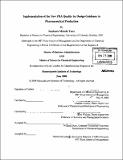Implementation of the new FDA quality by design guidance in pharmaceutical production
Author(s)
Tozer, Stephanie Michelle
DownloadFull printable version (34.01Mb)
Alternative title
Implementation of the new Food and Drug Administration QbD guidance in pharmaceutical production
Other Contributors
Leaders for Manufacturing Program.
Advisor
Charles Cooney and Roy Welsch.
Terms of use
Metadata
Show full item recordAbstract
Due to the highly regulated environment, it is difficult to implement changes to a pharmaceutical process. Even small change request approvals can require months of effort for pharmaceutical companies and regulatory agencies. This resource intensive process discourages continuous improvement and often results in outdated and inefficient manufacturing processes. In response to the growing need for improvement, the FDA issued a guidance to industry that provides a framework for acquiring improved process understanding and product quality in the manufacturing industry. The guidance is aimed at encouraging the use of process analytical technology (PAT) to monitor key quality attributes continuously during the process and enable early fault detection. The goal is to transition from the current method of quality through end of process testing to a new method of quality by design (QbD). In 2005 Novartis Pharma formed a unique collaboration with the FDA in an attempt to demonstrate the benefits and concepts of QbD. A cross-functional team was formed with the goal of developing a case study for one Novartis process that will serve as a model for future implementation of PAT and QbD.During a six month internship, I worked with the Global PAT team members to help ensure the successful implementation of the QbD tools outlined in the FDA Guidance. The internship focused only on the drug substance manufacturing process. Specifically, I was responsible for collecting and analyzing process data during the manufacturing campaign, coordinating the commissioning of an on-line NIR probe and PSD analyzer, and identifying and proposing future benefits of PAT applications to Novartis Pharma. (cont.) I also conducted a throughput analysis after observing manufacturing operations and analyzing the process data collected during the campaign.My thesis provides a background of the QbD/PAT initiative and includes a thorough literature search to benchmark the progress other pharmaceutical companies have made at applying QbD/PAT. I discuss in more detail the Novartis PAT project, and my specific contribution including the results of the NIR and PSD installation and validation, full scale Design of Experiment activities, Multivariate Data Analysis modeling, and process throughput analysis. I conclude with an analysis of barriers to implementation and provide recommendations for future implementation to other processes and plants at Novartis.
Description
Thesis (M.B.A.)--Massachusetts Institute of Technology, Sloan School of Management; and, (S.M.)--Massachusetts Institute of Technology, Dept. of Chemical Engineering; in conjunction with the Leaders for Manufacturing Program at MIT, 2008. Includes bibliographical references (p. 99-103).
Date issued
2008Department
Leaders for Manufacturing Program at MIT; Massachusetts Institute of Technology. Department of Chemical Engineering; Sloan School of ManagementPublisher
Massachusetts Institute of Technology
Keywords
Sloan School of Management., Chemical Engineering., Leaders for Manufacturing Program.